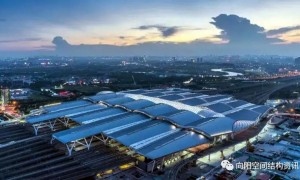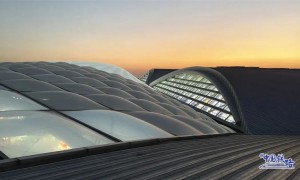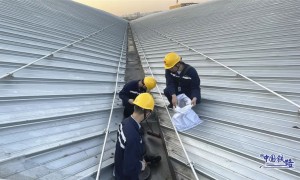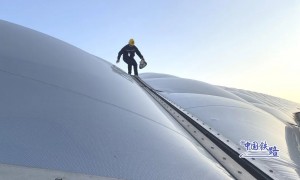Cold-formed steel heats up as mid-rise and framing option
Ian Harvey
冷弯型钢正在挑战工程木作为中高层建筑结构的选择
Cold-formed steel (CFS) is challenging engineered lumber as the material of choice for mid-rise structures, says Larry Williams, executive director for the Steel Framing Industry Association.
如果经济形势持续发展,CFS占比会更高
In fact, he adds, CFS could even go higher if the economics align.
我们做了一项研究,证明用CFS建造40层高的建筑从理论上是可行的,但经济上市没可能的。
“We had an engineering study done which shows it is feasible to go 40 storeys with CFS, though economically it isn’t viable,” he states.
To make it more viable, codes would have to be updated and other work carried out. Still, he says, it’s a promising future.
大家并不看好未来CFS在单户住宅的应用,但他们确实看好除了三层低层住宅外,CFS应用在多单元、多层建筑的潜力。
Proponents don’t see much of a future in residential single family homes but they do see potential in multi-unit, multi-storey structures beyond the three storey low-rise.
北美地区的建筑法规发生了变化,允许木质框架结构在中高层建筑中使用,这给该行业带来了小小的冲击。工程木曾短暂飙升,但情况又发生了逆转。
The sector took a small hit when building codes in jurisdictions across North America were changed to allow wood-framed structures for mid-rise application.
Engineered lumber surged briefly, Williams says, but things have swung back again.
之所以又反弹回来,是因为木材是易燃的,这个特性会让它在其它方面付出更多,此消彼长,后文会提到保险等事宜。
It’s rebounding partly because of the economics and partly because of the alleged risks inherent with wood’s vulnerability to combustion, especially during the construction phase, he notes.
现在北美在主推4-8层,争取9-12层
“We’re seeing a push to four to eight storeys and pushing to nine storeys and we think it could to go 12 storeys,”Larry Williams ,Steel Framing Industry Association
在建设阶段,木结构要缴纳更多的保险
The upshot, Williams says, is that insurance coverage during the construction phase is much more expensive and some carriers are demanding 24-7 live security.
以美国为例,建筑商的保险成本约为:混凝土100美元/9美分。CFS100美元/14 – 15美分,而木材是每100美元/89美分。这大大增加了开发成本。
“The costs of builder’s insurance with concrete (in U.S. figures) is about nine cents per $100 of value. CFS is 14 cents to 15 cents per $100 and wood is 89 cents per $100,” he says. “That’s substantially adding to the cost of development. One building was costed at US$300,000 for concrete and $1.2 million for lumber. The owner went for concrete.”
美国最近建筑业正在恢复
With the United States fully out of the recession following the 2008 financial crisis, he says construction has picked up and interest in CFS is rising.
“We’re seeing a push to four to eight storeys and pushing to nine storeys and we think it could to go 12 storeys,” he says.
瑞斯康建筑科学与创新总监保罗•德•伯拉迪斯(Paul De Berardis)表示,CFS通常用于大卖场等低层商业建筑。
Paul De Berardis, RESCON’s director of building science and innovation, says CFS is generally used for low-rise commercial structures such as big box stores.
“例如有一座轻骨架结构的独栋别墅建筑”他说“但问题是一,成本,这比木材还多,二,你不能像用木材那样切割它来制造托梁。这是一款经过设计的产品,所以你必须应对这些限制。
与美国不同,他没有听说加拿大有任何推动建设三层或三层以上的CFS的行动
“There is one building, Bone Structure, using it for custom single family homes,” he says. “The problem though is one, the cost, which is more than wood, and two, you can’t just cut it like you can with dimensional lumber to make a joist. It’s an engineered product so you have to work with those limitations.”
He says he hasn’t heard of any push in Canada to build three or more storeys with CFS, unlike the U.S.
然而,木材似乎正在为4到6层的项目取得进展,安大略省政府和该行业都在努力创造最佳实践,包括在施工阶段如何降低火灾风险的指导方针。“有了木材,你就有了一个成熟的供应链和贸易,”威廉姆斯说。
Wood, however, seems to be gaining ground for four-to six-storey projects and both the Ontario government and the industry are working to create best practices, including guidelines on how to reduce fire risk during the construction phase.
“With lumber, you have an established supply chain and trades,” Williams says.
The wood sector is investing heavily to promote their technology, Williams says, and steel will continue to market their option too.
“We’re at about 30 to 35 per cent of the market for low- and mid-rise, which is good,” he says.
安大略省Magest的总裁布罗克•马丁(Brock Martin)表示,尽管人们最初对中高层木框架房的兴趣激增,但CFS仍保持了稳定或增长。
Brock Martin, president of Magest in Ontario, which has specialized in CFS for 25 years, says even with the initial surge of interest in wood-frame mid-rises, steel has held steady or grown.
“我们的市场份额增长的相当不错,在2005年还得说破嘴的多层项目,CFS现在很容易被市场接受”
“Our market share is growing quite well,” he says. “In 2005 we had to fight for every job but today mid-rises, up to seven storeys or so, is more accepted for cold-formed steel.”
Magest项目遍布加拿大,包括酒店和老年人住宅。
“对于那些项目,他们当然喜欢不燃不燃的一面,”他说。
安赛乐米塔尔公司(ArcelorMittal Dofasco)全球研发建设经理迈克•斯蒂勒(Mike Stiller)表示。他说,多年来,CFS取景一直在加拿大悄悄地占有市场份额,特别是在ICI的项目上。
Magest has projects across Canada including hotels and a seniors residence.
“For those projects, of course they like the non-combustible aspect,” he says.
Mike Stiller, manager of global R&D construction at ArcelorMittal Dofasco in Hamilton, Ont., says CFS framing has been quietly holding market share for years in Canada, especially on ICI projects.
他表示:“医院和老年人住宅,甚至一些连锁酒店,都需要不燃性建筑,所以它们需要钢铁和混凝土。”“当然,对钢铁来说,中高端市场是个不错的选择。“当你考虑到整个生命周期的成本时,钢铁是不易燃的,在拆除或翻新时是完全回收的,这是非常可持续的,而且成本效益高。”钢铁不容易收缩或发霉,他说。他补充说,虽然不太可能在40层楼高的大厦框架内安装CFS,但没有理由认为CFS不应该成为中、高层建筑的可行选择。“就像这里的一位经理说的那样,钢铁公司总是有一个伟大的故事要讲,但问题是我们是糟糕的说书人,”斯蒂勒说。“我们正在改变这一点。
“Hospitals and seniors residences, even some hotel chains, need non-combustible construction so they go for steel and concrete,” he says. “Certainly, mid-rise is a sweet spot for steel. When you look at the cost over the life cycle, the fact steel is non-combustible and is wholly recycled at demolition or renovation, it’s very sustainable and cost efficient.”
Steel isn’t susceptible to shrinkage or mould, he states.
While a 40-storey tower framed with CFS isn’t likely, he adds, there’s no reason why CFS shouldn’t be a viable choice for mid-rises and up.
“As one of the managers here has said, ‘steel has always had a great story to tell but the problem has been we’re lousy storytellers,’ ” says Stiller. “We’re changing that.”
下面的内容貌似和轻钢没关系,是说一个取消什么能源计划的事情
Premiers from East and West express disappointment
OTTAWA — Premiers across the country are also reacting to news of the Energy East cancellation, with most stating it’s a huge blow to the country.
Alberta Premier Rachel Notley delivered a statement to media noting while the government understands it was driven by a broad range of factors, it is an unfortunate outcome for Canadians.
“Our government has supported Energy East since the project was proposed,” she said, adding the National Energy Board needs to send a clear message on what the future of project reviews looks like in Canada as investors need confidence. “This decision highlights the importance of diversifying market access and the subsequent national priority that must be placed on the Trans Mountain expansion project.”
Saskatchewan Premier Brad Wall was not as kind, calling the cancellation not a good day for Canada or the federation and a very bad day for the West.
“TransCanada made the decision to cancel Energy East — but make no mistake, the reasons for it fall at the feet of Prime Minister Justin Trudeau and the federal government,” said Wall in a statement. “They have been, at best, ambivalent about the project and then moved the goalposts at the last moment by asking the regulator to consider the impact of upstream greenhouse gas emissions.”
Wall added TransCanada committed more than a billion dollars to the project and made 700 changes to its plans in response to concerns.
“Make no mistake, other companies’ decisions to invest in Canada will be informed by this debacle,” said Wall, also criticizing that Western provinces send $2.5 billion in equalization payments to help support Quebec despite the fact that low energy prices have resulted in job losses and lower revenues for the last four years.
“Something needs to change,” Wall said. “For the West to continue on like this in our federal system is the equivalent of having Stockholm syndrome.”
New Brunswick Premier Brian Gallant said in a statement to constituents that TransCanada’s decision is “not good news for those who wanted to see the Energy East pipeline built — and your provincial government falls firmly in that camp. Like many New Brunswickers, we are disappointed. The project would have created jobs in New Brunswick and helped the Canadian economy.”
Federal Energy Minister Jim Carr told the media TransCanada’s decision was motivated by business considerations influenced by the state of commodity prices. He also noted the government already approved two other projects, the Trans Mountain and Line 3 expansions.
— With files from the Canadian Press









